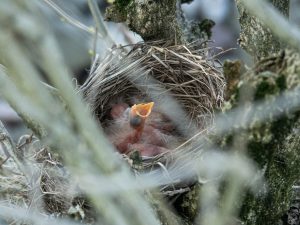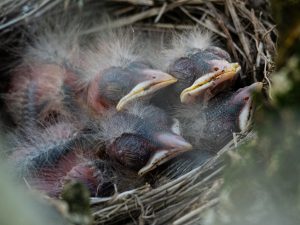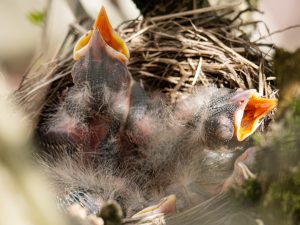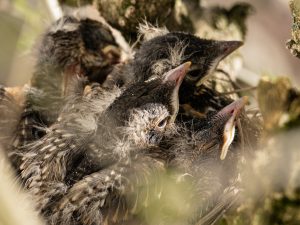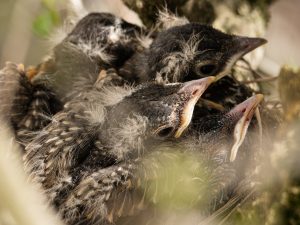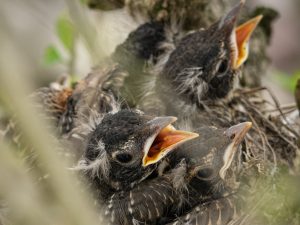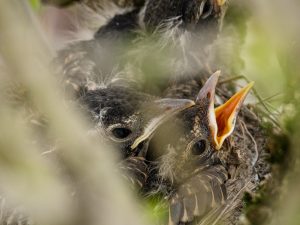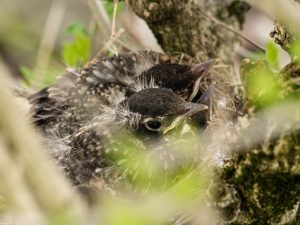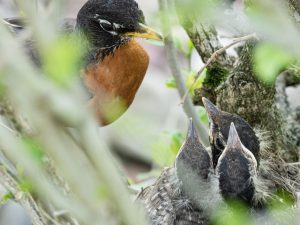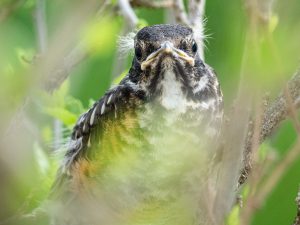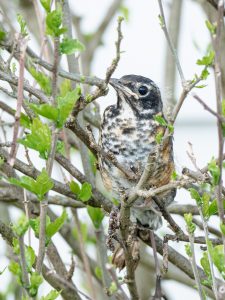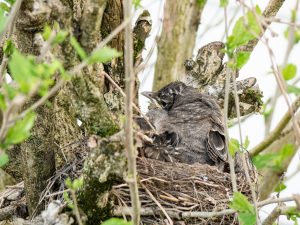Backyard Robins
In late April 2020, while residents of Northeastern PA were in their second month of a stay-at-home order due to Covid-19, I discovered that I was about to have new neighbors. A pair of adult American robins was building a nest in the Rose-of-Sharon outside my bedroom window.
The nest was low to the ground – too low to be safe, I thought. And the Rose-of-Sharon is a late-bloomer, only starting to get leaves by late May, and further delayed by several May frosts that stunted the growth of all my plants. Were these first-time robin parents? Or just risk-takers? Then again, what did I know? I’m not a robin.
Through the slats in my bed’s headboard and the window behind it, I was able to watch construction of the nest, and then the appearance of four small blue eggs. Not wanting to frighten the robins during this phase, I didn’t begin to take photos until after the eggs had hatched, waiting until both parents were foraging in the yard for food before I’d open the window.
There was an opening in the Rose-of-Sharon’s branches that was just right for me to aim the lens through and watch as the tiny, nearly-naked chicks began to grow.
13 May 2020
Only a day or two after hatching, the robin nestlings are mostly naked save for a thin coating of fluff. Their puffy eyes have yet to open, and they look more like strange, pink goldfish than they do birds. They hardly respond to their parents when they arrive with food, seemingly unaware of much of the world around them.
16 May 2020
The nestlings’ eyes are beginning to open, and pin feathers are starting to show across their bodies, joining the fluffy tufts that cover their heads. They spend their time sleeping, huddled together until a parent arrives with food. Then they stretch their necks up, beaks open, silently begging.
17 May 2020
The nestlings’ feathers are starting to grow in, giving them a spiky appearance, like small not-so-fearsome dinosaurs.
20 May 2020
In the few days that have passed, the nestlings’ eyes have fully opened. Their feathers are starting to grow in, and they are finally beginning to look like proper birds. They beg for food when their parents arrive – and often when their parents aren’t even present.
Their parents are foraging constantly. They move up and down my lawn, through my gardens, flinging mulch chips as they look for food. Mainly I see them come back with worms, four more draped over their beaks on each trip. It’s enough to feed two, or maybe three, nestlings at a time and satisfy them for a few minutes, before they begin begging again.
21 May 2020
The chicks’ flight feathers are growing in, individual wing feathers visible. They are still small, but growing quickly, and the chicks are growing with them. All four of them are squeezed into the nest together, and they are running out of room. It will be tight quarters from here on out.
22 May 2020
The chicks are vocal now. When their parents arrive with food, they stretch out their necks as always, but now with a staccato of soft, high-pitched cheeps. Then, as their parents fly away, they fall silent again, sinking back down into their nest.
They know when I’m watching, and have for several days. They see me in the window, and when I open the window I’m met with dark-eyed watchfulness. They don’t seem afraid, just very aware.
24 May 2020
Something happened since the 22nd, and now there are only three chicks left in the nest. I looked from the window, and from the yard, and didn’t find a body nearby. It’s most likely that one of the chicks fell out of the nest – or perhaps was pushed out by a sibling while they were trying to shift positions.
The neighbor’s big orange tomcat walks through at least once day, and if he found a chick on the ground, he could easily have carried it off. Neither the parents nor the other chicks show any sign of noticing that their numbers are down by one, although there’s no doubt that with one less mouth to feed, the parents’ job is that much easier.
25 May 2020
The chicks are growing restless. They have begun to flap their wings experimentally, flexing new muscles, and, I suppose, feeling the instinct that leads them to fly. Even as I watched, the first chick hopped up onto the edge of the nest, and, instead of moving back, he forged ahead. He made his way up through the Rose-of-Sharon, from branch to branch, until he reached the edge. He sat there for several minutes; when I checked back a short time later, he was gone.
I found him later, outside, near the back of my yard, 30 feet away. And then again sitting on my porch railing. He didn’t seem frightened by me, and sat so still that I didn’t even see him at first when I went out on the porch for my shoes. After that, he flew down my driveway towards the street, his flying-skills still awkward. I haven’t seen him since, but hope that he’s nearby, waiting in a tree for his parents to feed him still.
26 May 2020
When I went to bed on the evening of the 25th, there were still two chicks left in the nest. When I got up at 6am on the 26th, there was only one, and I can only assume that her other sibling made his way to the edge of the bush and took off.
When I looked again no more than 10 minutes later, the final chick was sitting on the edge of the bush. And then she flew. I got a final photo of her sitting on my neighbor’s basement windowsill. She didn’t fly far, only three or four meters, but it was still a big step.
Now the nest is empty. I keep looking out the window, already in the habit of checking in on them throughout the day. It’s strange that they’re not there anymore, but I’m hopeful that the remaining three, fledglings all, will survive to adulthood.

